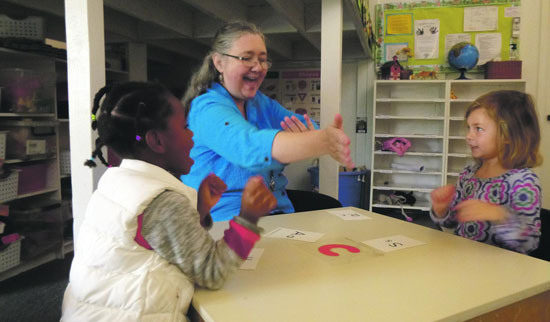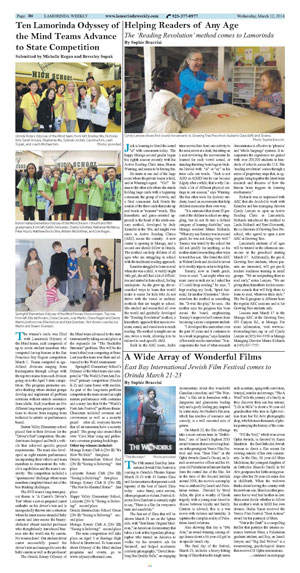|
|
Published March 12th, 2014
|
Helping Readers of Any Age
The 'Reading Revolution' method comes to Lamorinda
|
| By Sophie Braccini |
 |
| Cyndy Lemyre shows first sound movements to Growing Tree Preschool students Clara (left) and Sloane. Photo Sophie Braccini |
Jack is learning to blend the sound "ai" with consonants today. The happy Moraga second grader began his eighth session recently with his Active Reading Clinic tutor, Sharon Winning, and seems to be having fun.
 He starts at one end of the large room where the private lesson is held, and at Winning's signal - "Go!" - he runs to the other side where she stands holding large cards with a beginning consonant, the group of vowels, and a final consonant. Jack blends the sounds of the three cards that make up real words or "monster" words. This kinesthetic and game-oriented approach is the heart of the multi-sensory method, developed by Judy Kranzler in the '80s, and taught ever since in Active Reading Clinics (ARC) across the country. A new center is opening in Moraga, and a second one should follow in Orinda. The method can help children of all ages who are struggling in school with the traditional reading approach.
He starts at one end of the large room where the private lesson is held, and at Winning's signal - "Go!" - he runs to the other side where she stands holding large cards with a beginning consonant, the group of vowels, and a final consonant. Jack blends the sounds of the three cards that make up real words or "monster" words. This kinesthetic and game-oriented approach is the heart of the multi-sensory method, developed by Judy Kranzler in the '80s, and taught ever since in Active Reading Clinics (ARC) across the country. A new center is opening in Moraga, and a second one should follow in Orinda. The method can help children of all ages who are struggling in school with the traditional reading approach.
 Kranzler struggled to learn to read when she was a child. A visibly bright little girl, she still had a lot of difficulties and started to hate school, feeling inadequate. As she grew up, she researched ways to learn that would make it easier for kids who do not thrive with the visual or auditory methods that are taught in school. She studied and researched all over the world and gradually developed the "Reading Revolution" method, a kinesthetic approach that uses movement, sound, and visual tools to teach reading. The method is taught one on one, twice a week, allowing it to be tailored to each specific child.
Kranzler struggled to learn to read when she was a child. A visibly bright little girl, she still had a lot of difficulties and started to hate school, feeling inadequate. As she grew up, she researched ways to learn that would make it easier for kids who do not thrive with the visual or auditory methods that are taught in school. She studied and researched all over the world and gradually developed the "Reading Revolution" method, a kinesthetic approach that uses movement, sound, and visual tools to teach reading. The method is taught one on one, twice a week, allowing it to be tailored to each specific child.
 Back in the ARC room, Jack's tutor moves him from one activity to the next, never at a desk, but sitting on a mat reviewing the movements he learned for each vowel sound, or standing throwing bean bags in buckets labeled with "ai" or "ay" as his tutor calls out words. "Jack is not ADD or ADHD but he can become fidgety after a while; that is why I include a lot of different physical settings in our session," says Winning. She has other tools for dyslexic students, based on movements that help children memorize their own way.
Back in the ARC room, Jack's tutor moves him from one activity to the next, never at a desk, but sitting on a mat reviewing the movements he learned for each vowel sound, or standing throwing bean bags in buckets labeled with "ai" or "ay" as his tutor calls out words. "Jack is not ADD or ADHD but he can become fidgety after a while; that is why I include a lot of different physical settings in our session," says Winning. She has other tools for dyslexic students, based on movements that help children memorize their own way.
 "It is estimated that about 20 percent of the children in school are struggling, but do not fit into a defined category of learning disability," says Moraga resident Maura Richards. "When my son Tommy was in second grade, he was not doing very well." Tommy was tested by the school but did not qualify for anything, so his mother started researching other ways to teach her son. She found the ARC in Walnut Creek and decided to invest in bi-weekly trips in order to help him.
"It is estimated that about 20 percent of the children in school are struggling, but do not fit into a defined category of learning disability," says Moraga resident Maura Richards. "When my son Tommy was in second grade, he was not doing very well." Tommy was tested by the school but did not qualify for anything, so his mother started researching other ways to teach her son. She found the ARC in Walnut Creek and decided to invest in bi-weekly trips in order to help him.
 Tommy, now in fourth grade, loves to read. "Last night when my mom came to tuck me in I asked her if I could keep reading," he says. "I kept reading my book, 'Spirit Animals,' for another 30 minutes." He remembers the method as something fun. "It was like play," he says. His mother says his progress has been across the board, emphasizing Tommy's improved self-esteem from becoming a more competent student.
Tommy, now in fourth grade, loves to read. "Last night when my mom came to tuck me in I asked her if I could keep reading," he says. "I kept reading my book, 'Spirit Animals,' for another 30 minutes." He remembers the method as something fun. "It was like play," he says. His mother says his progress has been across the board, emphasizing Tommy's improved self-esteem from becoming a more competent student.
 "I developed this curriculum over the past 30 years and it continues to be a work in progress," says Kranzler of her multi-media curriculum. "It incorporates the best of what research demonstrates is effective in 'phonics' and 'whole language' systems. It incorporates the experience we gained with over 200,000 students in hundreds of schools across the U.S. The 'reading revolution' comes through a series of proprietary steps that, in aggregate, bring together the latest brain research and theories of how the human brain triggers its learning mechanisms."
"I developed this curriculum over the past 30 years and it continues to be a work in progress," says Kranzler of her multi-media curriculum. "It incorporates the best of what research demonstrates is effective in 'phonics' and 'whole language' systems. It incorporates the experience we gained with over 200,000 students in hundreds of schools across the U.S. The 'reading revolution' comes through a series of proprietary steps that, in aggregate, bring together the latest brain research and theories of how the human brain triggers its learning mechanisms."
 Richards was so impressed with ARC that she decided to work with Kranzler and her managing director Cyndy Lemyre to open an Active Reading Clinic in Lamorinda. Richards introduced the method to Linda Richardi and Terri Giovanetti, the co-directors of Growing Tree Preschool, who agreed to open a new ARC at Growing Tree.
Richards was so impressed with ARC that she decided to work with Kranzler and her managing director Cyndy Lemyre to open an Active Reading Clinic in Lamorinda. Richards introduced the method to Linda Richardi and Terri Giovanetti, the co-directors of Growing Tree Preschool, who agreed to open a new ARC at Growing Tree.
 Lamorinda students of all ages will be tutored in the afternoon one-on-one at the preschool starting March 17. Additionally, the pre-K Growing Tree students, whose parents are interested, will get pre-K readers' readiness training in small groups. "We are not pushing them to read early," notes Lemyre. "We are giving them kinesthetic tools to memorize sounds that will help them to learn to read, whatever their style." The Pre-K program is different from the regular ARC sessions and is for Growing Tree students only.
Lamorinda students of all ages will be tutored in the afternoon one-on-one at the preschool starting March 17. Additionally, the pre-K Growing Tree students, whose parents are interested, will get pre-K readers' readiness training in small groups. "We are not pushing them to read early," notes Lemyre. "We are giving them kinesthetic tools to memorize sounds that will help them to learn to read, whatever their style." The Pre-K program is different from the regular ARC sessions and is for Growing Tree students only.
 Lessons start March 17 in the Moraga ARC at the Growing Tree, 695 Canyon Rd., in Moraga. For more information, visit www.activereadingclinic.org or call Cyndy Lemyre at (925) 944-5559 or Moraga Managing Director Maura Richards at (415) 637-7757.
Lessons start March 17 in the Moraga ARC at the Growing Tree, 695 Canyon Rd., in Moraga. For more information, visit www.activereadingclinic.org or call Cyndy Lemyre at (925) 944-5559 or Moraga Managing Director Maura Richards at (415) 637-7757.

|
|
|
|
|
|
|
|
|
|
|
|



